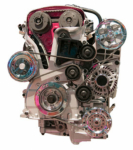News & Media
Beyond "Fantastic Voyage"... Drug delivery research at UCSB

In the 1966 science fiction film Fantastic Voyage, the principals were put in a submarine which was then shrunk to one micron in length and injected into a comatose scientist’s body so that they could navigate through the body to the site of a life-threatening cerebral blood clot and destroy it. That was a fantasy approach to getting the right therapy to the place in the body it’s needed, but at UC Santa Barbara, cross-disciplinary teams of researchers from materials science, chemical and mechanical engineering, biology, and chemistry are creating drug delivery technologies that do just that and more—drug delivery technologies that are more targeted, effective, and efficient, and at the same time safer and cheaper, than those in use today. […]
Frank Doyle, professor of chemical engineering, focuses on controlled drug delivery for one very specific medical issue: improved insulin dosing for Type 1 diabetes.
Doyle and his research group are developing an artificial pancreas system (APS) which will automatically maintain desired blood sugar levels without patient involvement, monitoring and adjusting those levels by administering insulin.
Control Freaks

Saving energy can be as simple as turning off the lights when you leave a room and as elaborate as the network of little machines in a modern control system. The typical automobile is controlled for fuel efficiency at several crucial points, including the fuel injection system, the exhaust, air intake, engine cooling, air conditioning and transmission. Among other things, sensors and computers control the mix of fuel and air, choose the most efficient gear and regulate the flow of engine coolant. Much more elaborate systems control jetliners and spacecraft, for stability and safety as well as efficiency. And the future promises much more of this technology, at higher levels of precision, interaction and complexity.
Researchers at UC Santa Barbara’s Center for Control, Dynamical Systems and Computation (CCDC) have long been working at the frontiers of control engineering. This field draws on the disciplines of mathematics, computer science and several branches of engineering – computer, chemical, electrical and mechanical.

